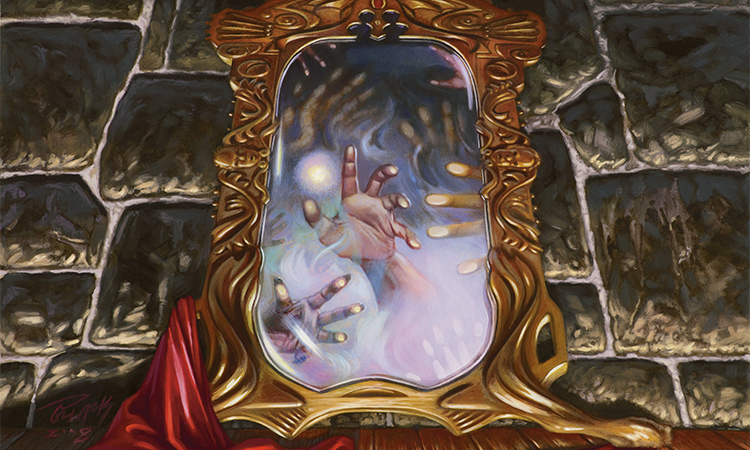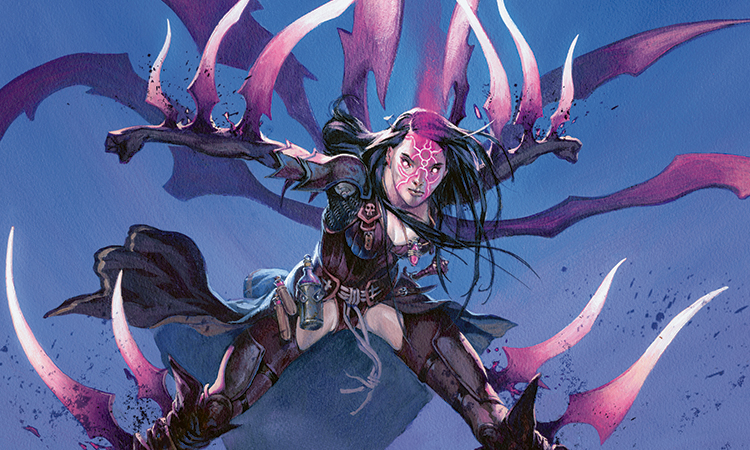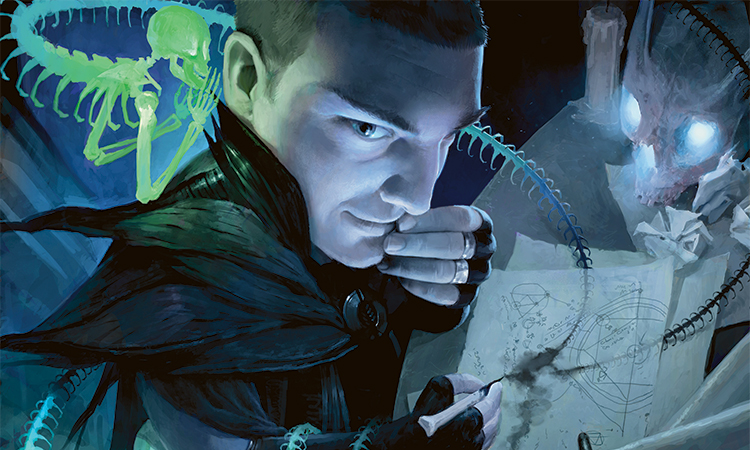Topical Blend: Did You Hear the One About...
Did You Hear the One About...
"I hear Maro says that for every card that gets printed, there's another 99 that never see the light of day. Can that possibly be true?"
"I've heard some stories."
"What do you mean?"
"Well, I've been playing Magic for a long time and I have friends who have friends who know people who've worked at Wizards of the Coast, some in the R&D department."
"So?"
"Well, they talk, you know, off the record, and I've heard things."
"Like what?"
"Like stories. You want hear some of them?"
"Yes!"
"Okay, I call this first one 'The Message in the Mirror.' It all starts many years ago, when R&D was working on the set called Tempest. This story is about Maro and two young interns whose names are lost to time. Most people don't know this, but Maro wasn't actually hired as a designer but rather as a developer. He was eager, though, to prove that he could design, so he got Richard Garfield to agree to work with him on a new set. That was enough to allow the head designer at the time, a man named Joel Mick, to give him a shot leading a design."
"His first time designing was leading a set? That doesn't sound very plausible."
"Let me tell my story and then you can decide for yourself whether it's true or not. Anyway, there was a lot of pressure on Maro to deliver an exciting design, so he decided to push the boundaries. He made a new mechanic that allowed you to choose to start with the card in your opening hand. If you chose to do so, you had to begin with one card fewer."
"Just one card fewer? That's all? There wasn't a life loss or something?"
"The cards were weaker than normal, so you were opting to start with cards that were of a lower power level. Maro was excited by this idea. Everyone gets frustrated when they can't get the card they need. What if you had the ability to guarantee that you could have the card you wanted in your opening hand? But it was a bit of a crazy idea, so Maro knew it needed to be playtested. Luckily, Magic R&D had two young interns who were available for playtesting. He asked them to play in a room with a one-way mirror so he could secretly observe. The playtesting went on all night and Maro had had a long day, so several hours in, he fell asleep."

Mirror of Fate | Art by Alan Pollack
"What happened next?"
"Early the next morning, Maro awoke to see a message written in lipstick on the mirror, reversed so he could easily read it. It read: 'DECK VARIANCE IS THE LIFEBLOOD OF THE GAME AND UNDERCUTTING IT WITH THIS MECHANIC HAS LED TO THE MOST UNFUN PLAYTEST GAMES WE HAVE EVER PLAYED. IF THIS IS THE FUTURE OF MAGIC DESIGN, WE WANT NOTHING TO DO WITH IT.' The interns were gone and haven't ever been seen since. Maro took the new mechanic out of the file and never talked about it again."
"Wow!"
"Want to hear another story?"
"Of course."
"I call this next one 'The Designer and the Phone Call.' Brian Tinsman was leading the design for Avacyn Restored. Maro had suggested a mechanic based on something Richard Garfield had done at the previous year's World Championship, where he had brought a deck to spellsling with made up entirely of cards he had designed. In it was a mechanic where he shuffled useless cards into the opponent's deck. Maro liked the idea of cards that didn't start in a player's deck but through some means could be added. Instead of it being a negative thing, though, Maro liked the idea of positive cards, things that would look very attractive—for example, a Lightning Bolt that dealt 5 damage to a creature or player but only cost a single red mana."
"Wouldn't that just be too good?"
"You see, these cards, which Maro dubbed 'forbidden,' weren't allowed to start in a deck. You had to cast other cards that would let you shuffle some number of the forbidden cards into your deck and then you had to draw them. The mechanic was a bit out there, but Brian loved pushing the envelope, so he put the cards in the file. Then one day his phone rang. He picked it up and heard a voice say, 'Take the forbidden cards out of the file.' Brian had no idea who was calling, but he had grown very fond of the mechanic and wasn't about to take it out."
"This is the set on Innistrad when Avacyn gets released?"
"Exactly. Brian thought that the forbidden mechanic mirrored how the Angels and Demons had been trapped in the Helvault. The design team played with the mechanic, fine-tuning it. They started to figure out what kind of cards wanted to shuffle forbidden cards into the deck and how to make them something players would want to play whether or not they had forbidden cards in their Limited pools. The idea was as you were building your deck, you would end up with a few of these cards, so you'd grab a few forbidden cards from your card pool just in case. But one day during design, the phone on his desk rang again. A voice said, 'Take the forbidden cards out of the file. If you don't, bad things will happen.' Brian was a little worried, so he called the police. They asked him if the call was a threat, and Brian said not exactly. The person was just telling him to change his design, and Brian wasn't willing to do that. The police said there was nothing they could do."
"Really?"

Vow of Malice | Art by Jesper Ejsing
"Well, the threat was at best implied, and even then it was very vague. Brain was determined to ignore it and pushed on with the forbidden mechanic. He started working with the creative team to get a better sense of what the forbidden cards represented, and he started having discussion about a new frame treatment for them. But then the phone rang again. The voice on it said, 'Take the forbidden cards out of the file. Many will be unhappy if you don't.' This was freaking Brian out, so he called the police again. Sensing the fear in his voice, they said they would trace the next call to find out where it was coming from."
"And when was that?"
"Just a few days later. The phone rang and the voice said, 'Take the forbidden cards out of the file. They shouldn't be made.' As soon as Brain hung up, the police called. They said the call was coming from inside the building! It was... development! They said the mechanic couldn't be balanced, caused all sorts of tournament issues—and oh, the shuffling! Brian took out the forbidden mechanic and replaced it with miracles. But to this day, he still twitches slightly whenever the phone rings."
"Cool!"
"Want to hear another?"
"I do."
"I call this next one 'The Morning After.' Ken Nagle was working on New Phyrexia. It was the culmination of a block-long storyline about an epic war between the Mirrans and the Phyrexians. There was a mystery surrounding which side would win, and two different names for the sets had been announced. Ken was eager to make sure the set delivered with a splashy culmination to the story and was eager to find a cool, larger-than-life mechanic. He thought he had found one with a mechanic called link. Inspired by B.F.M. from Unglued, the idea of creatures that were made up of more than one card had been bandied about for years, but Ken wanted to take the idea to the next level. What if there were right sides and left sides of cards and you could play any right side along with any left side?"
"Could you play just a right side or a left side?"
"No, each side required one of the other in order to cast it. The mechanic didn't care which right side or which left side you had, but you needed one of each. The idea was that you could mix and match to create a variety of creatures, and that each half would define part of what the creature was, both how big and with what abilities. Now, the art team was very skeptical. The graphics to make something like this work would be very odd, more like something out of a children's mix-and-match book than the style of art one would expect of a Magic set. There were card-layout concerns. Where exactly would you lay out the text and how would you be able to convey what each combination did? There were both rules and templating concerns. Making the link cards work would require a lot of time and attention."
"So Did Ken give up?"
"No, Ken was determined to make the mechanic work; whenever a problem arose, he tried even harder to find a solution. The set was deep into devign—the period between design and development—when Aaron Forsythe asked Ken out to dinner. Aaron was going to be the lead developer for the set and was hoping to talk through various concerns he had. The restaurant was near work, so Ken decided to walk there. While he was on his way, a dark van drove up, and Ken was pulled inside. The next thing he knew, he was waking up in a tub filled with ice."

Surgical Extraction | Art by Steven Belledin
"How did that happen?"
"Listen to the story. Ken awoke and saw that on the rim of the tub was his cell phone and a message on a note card that read 'Call 911.' Ken called and explained his situation. The 911 operator, upon hearing about the tub of ice, told Ken not to move—the life of his set might depend upon it. She told Ken to feel around in the tub to see if he could find a card file. Ken found it and it was New Phyrexia. The operator told Ken to brace himself. The New Phyrexia file was missing the link mechanic. It had been removed. Aaron had realized that Ken was having problems letting it go, so he surgically removed it while Ken was away from the file."
"And then what?"
"Well, Aaron wasn't heartless. Also in the tub, Ken found a brand-new mechanic, Phyrexian mana, waiting to be implanted. Ken stuck the new mechanic in his set, but there are those who say Ken still spends nights and weekends hunting down the lost link mechanic."
"I didn't see that one coming."
"Would you like to hear one more?"
"Yes!"
"I call this one 'The Mechanic That Time Spiral Forgot.' Our final story today goes back to where we started, with a story about Maro. The set was Time Spiral. Maro was on the design team, and he was eager to find a splashy rare cycle that played into the set's theme of 'the past,' a high-profile 'hook' for the set. To do this, he knew he needed to find some rule that the game had never broken. The new mechanics wanted to be about the past, so Maro got an idea into his head. What if there were certain cards that allowed you to put cards into your deck that you might not normally be able to play? Maro was focused on Standard. If Time Spiral was about the past, what if it let you bring cards from the past and put them into a deck in the present?"
"What does that mean?"
"I'm getting there. Patience. Maro's idea was having the card say that if it was in your deck, then you were allowed to have up to four copies of a card from the past in your deck—even if that card wasn't normally legal in Standard. Understanding that there were many broken cards from the past that would disrupt Standard, Maro set out to find subsets of cards that would be acceptable. The first one he found was the creature type Wizard. At the time, the most powerful Wizard historically was Meddling Mage, and Maro believed that development was okay with that being in Standard, assuming it only went in a deck that supported this one particular card. So for example, blue's member of this cycle was a creature that was creature type Wizard, and if you had one in your deck then you could have anywhere from one to four copies of any Wizard from anywhere in the game's history. As you could have up to four copies of this blue card, your deck could have up to four different Wizards cards from the past, each up to four copies."
"What about Snapcaster Mage?"
"That Wizard didn't come out until Innistrad many years later. Maro looked to find other subsets of cards—things such as artifacts with a converted mana cost of 6 and enchant creature spells. He found six subsets, one for each color and one artifact. Each one was a member of the subset that it enabled. Maro was excited to type his new 'hook' into the set, but as he was about to sit down, he heard a news broadcast. It turned out that there was an escape from the Renton Insane Asylum and Wizards was sending everyone home. But the file was due that day to development, and Maro really wanted his cycle in the file. His coworkers said it wasn't worth the risk. The file was in fine shape. It didn't needed the 'hook' of the rare cycle. Anyway, it was a bit weird and no one quite knew the ramifications of letting old cards into Standard. Maro was willing to stay and type it in, but at the pleading of his coworkers, he relented and went home."

Whispering Madness | Art by Clint Cearley
"Is that the end?"
"Hold on. The next day everyone returned to the office. Someone had ripped open the door, and from the look of things they had wandered around the office. Maro was even convinced that they had sat in his chair. Maro quickly checked his desk to find his cycle, as although he knew he had missed the deadline to get it into the design file, he was planning to give it to development anyway. But when he looked around his desk, he realized the hook was gone. No one knows what became of that lost cycle. There are many who believe it resides in the pocket of a madman who to this day has never been caught."
"So, were any of these stories true?"
"That's what they say."
"I still don't thinking leading the first design team you're on makes any sense."
"Those 99 other cards have to do something. Who's to say these stories don't have at least a grain of truth?"
"Do you have any more stories?"
"Not about R&D, but let me tell you one about the finals of a major tournament from way back in the day. I call this one Order and Chaos Orb..."
"Drive to Work #284—10 Things Every Game Needs—Hook"
This is the tenth and final podcast in my "10 Things Every Game Needs" series. In it, I talk about the final piece your game needs: a hook with which to sell it.
"Drive to Work #285—Lessons Learned—Gatecrash"
This is another in my "Lessons Learned" series where I talk about the design lessons I got from sets I led. Today, I talk about the first set I co-led (with Mark Gottlieb), Gatecrash.
- Episode 285 Lessons Learned—Gatecrash (15.9 MB)
- Episode 284 10 Things Every Game Needs—Hook (17.4 MB)
- Episode 283 20 Years Later (17.0 MB)
- Episode 282 Most Asked Questions (17.9 MB)
- Episode 281 Social Media (16.7 MB)

